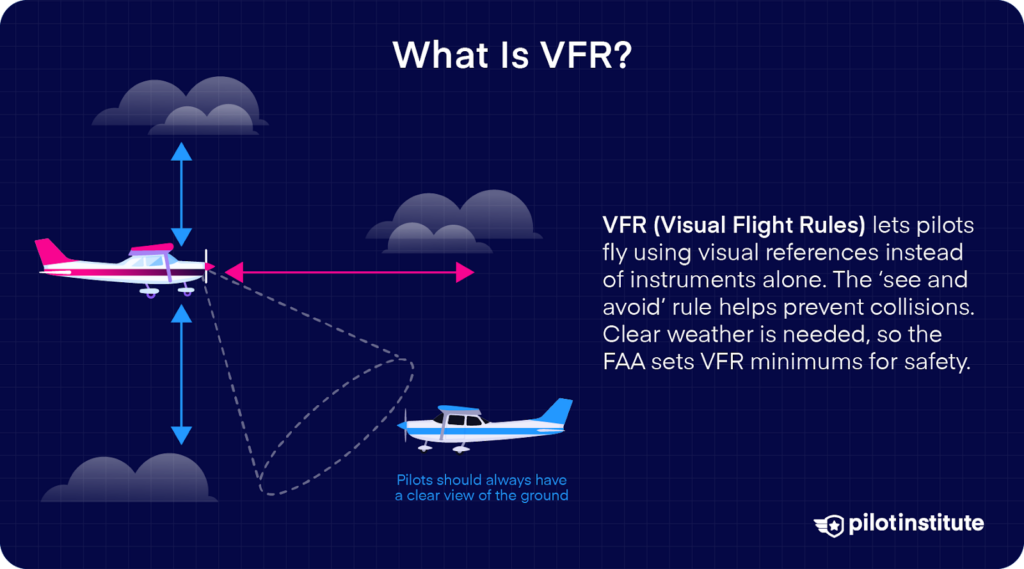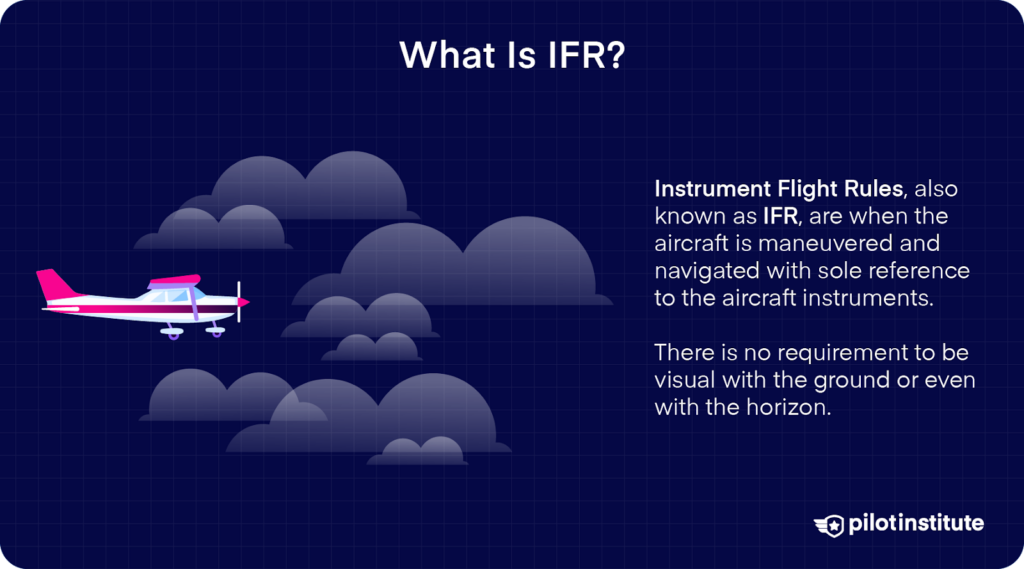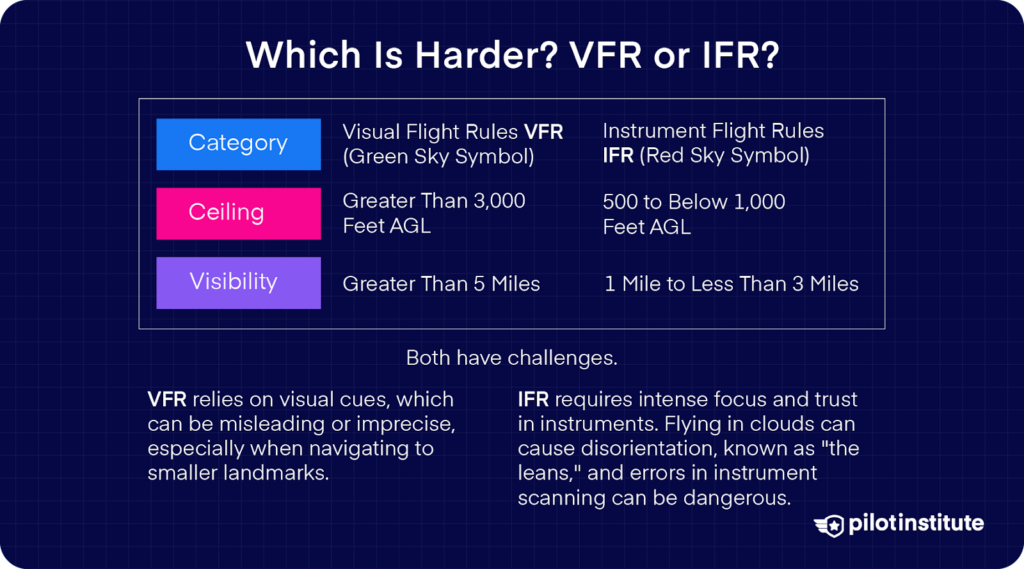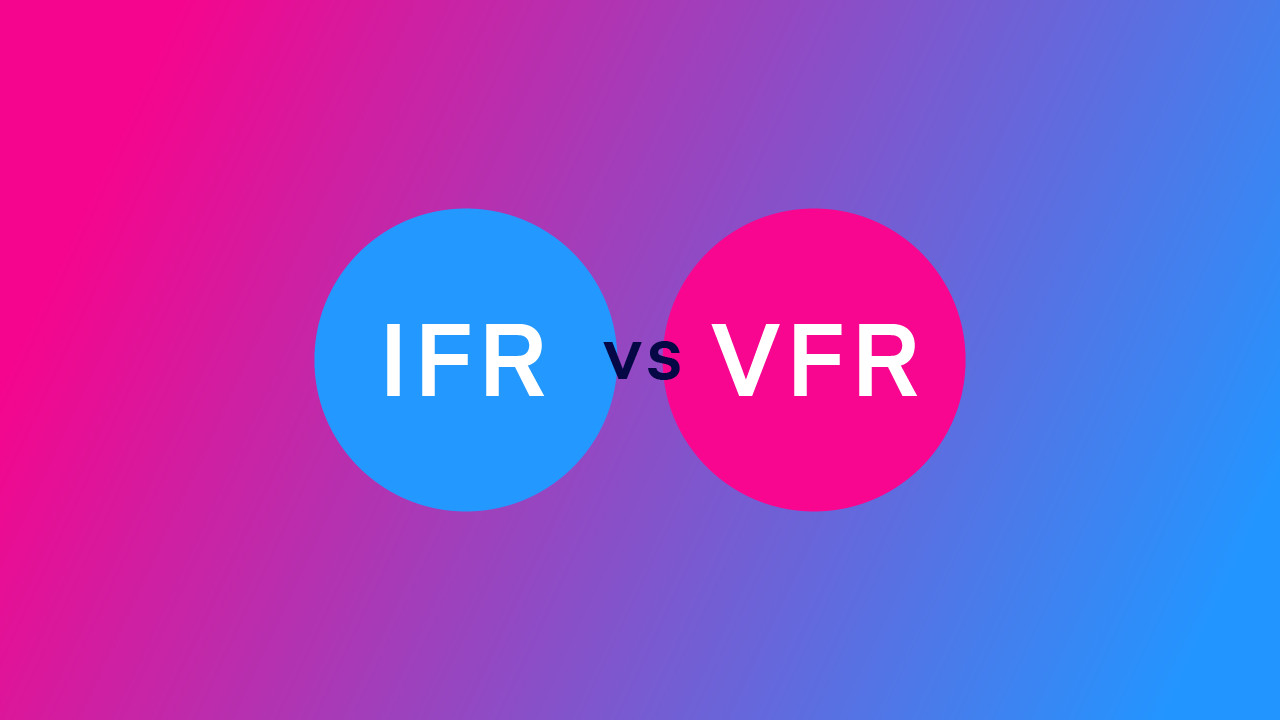When we think of piloting aircraft, we often conjure images of the pilot sitting transfixed on the airplane instruments. While this is often true, it is not always the case.
In fact, there are two different ways that airplanes navigate. One way is by using the instruments. The other uses a much older instrument—the human eyeball, otherwise known as flying visually.
In this article, we will look at both methods as we discuss IFR vs. VFR flight.
VFR is short for ‘visual flight rules’, meaning the pilot primarily controls and navigates the aircraft using outside visual references.
IFR stands for ‘instrument flight rules’. The aircraft is flown using only the instruments with no visual references to the outside world.
Ready to learn more? Let’s get started!
Key Takeaways
- VFR uses visual cues; IFR relies on instruments.
- VFR needs good weather; IFR works in any conditions.
- IFR is precise and flexible; VFR offers scenic simplicity.
- Both methods have unique challenges and rewards.
What Is VFR?

Visual flight rules, or ‘VFR’, refer to flying using primarily visual references. The pilot will still use the instruments to relay certain information, such as altitude and airspeed. But, what they see outside the window is used to determine the aircraft’s position and attitude.
When flying VFR, the general principle of ‘see and avoid’ is of paramount importance regarding other air traffic, especially in busy airspace. It is up to each pilot to maintain a good lookout to avoid airborne collisions.
As a result of the above, VFR comes with certain caveats. Namely, the weather must be good enough for the pilot to see out of the window! If there is no visible horizon, or the visibility is not good enough to spot other aircraft, this can make visual flying challenging and even dangerous.
To guard against this, the Federal Aviation Administration publishes rules regarding how good the weather must be for you to fly VFR.
These are called VFR minimums.
You can read more about VFR minimums below.
What Are the Benefits of Flying VFR?
There are many reasons why you may want to fly VFR, such as: –
- Great views! – VFR flying is all about looking out of the window!
- VFR flying is easier – VFR flying is a skill that most flight students pick up quickly.
- There are fewer rules – What you see is what you get. Literally, you look at where you want to go and point the airplane in that direction.
What Is IFR?

Instrument flight rules, also known as IFR, are when the aircraft is maneuvered and navigated with sole reference to the aircraft instruments. There is no requirement to be visual with the ground or even with the horizon.
The pilot will be able to work out their altitude, speed, attitude rate of climb, heading, and even their position over the ground using the basic instruments, colloquially known as ‘the six pack’, in combination.
Flying IFR takes a lot of practice and relies on the pilot having a good ‘scan’ where they look briefly at each instrument in a sequence to build a good overall mental picture of what is happening to the aircraft.
What Are the Benefits of Flying IFR?
You’ll need to be qualified to fly IFR, but once you are, you’ll get the following benefits: –
- You can fly in practically any weather – You don’t need to see outside the cockpit to fly IFR. As a result, you can fly in clouds, fog, and even at night!
- You can fly in more restrictive airspace – Certain classes of airspace are for IFR traffic only. No VFR allowed!
- IFR flying is more precise – Instruments remove some uncertainty, especially regarding your position. This can make it easier to navigate and pinpoint your position.
When Can You Fly VFR? Understanding VFR Minimums and Airspace

As we said above, the weather must be better than a certain level when flying VFR. There are two general elements to VFR minimums: –
- Forward visibility
- Distance from the cloud (both vertically and horizontally)
The general aim of minimums is to ensure you can see where you are going and make sure you absolutely steer clear of cloud!
VFR minimums are variable too.
Why?
Because they change based on the class of airspace you are in, and also with your altitude! This change is because controlled airspace tends to have a higher density of fast-moving traffic. You’ll find that controlled airspace has more restrictive minimums than uncontrolled airspace.
Where can I find the FAA minimums for VFR flight?
You can see a table detailing the VFR minimums in Title 14 of the Federal Code of Regulations, Part 91, Subpart B, rule 155…
| Airspace | Flight Visibility | Distance from Clouds |
| Class A | Not Applicable | Not Applicable |
| Class B | 3 statute miles | Clear of Clouds |
| Class C | 3 statute miles | 500 feet below1,000 feet above2,000 feet horizontal |
| Class D | 3 statute miles | 500 feet below1,000 feet above2,000 feet horizontal |
| Class ELess than 10,000 feet MSL | 3 statute miles | 500 feet below1,000 feet above2,000 feet horizontal |
| At or above 10,000 feet MSL | 5 statute miles | 1,000 feet below1,000 feet above1 statute mile horizontal |
| Class G1,200 feet or less above the surface (regardless of MSL altitude). | ||
| For aircraft other than helicopters: | ||
| Day, except as provided in §91.155(b) | 1 statute mile | Clear of clouds |
| Night, except as provided in §91.155(b) | 3 statute miles | 500 feet below1,000 feet above2,000 feet horizontal |
| For helicopters: | ||
| Day | ½ statute mile | Clear of clouds |
| Night, except as provided in §91.155(b) | 1 statute mile | Clear of clouds |
| More than 1,200 feet above the surface but less than 10,000 feet MSL. | ||
| Day | 1 statute mile | 500 feet below1,000 feet above2,000 feet horizontal |
| Night | 3 statute miles | 500 feet below1,000 feet above2,000 feet horizontal |
| More than 1,200 feet above the surface and at or above 10,000 feet MSL. | 5 statute miles | 1,000 feet below1,000 feet above1 statute mile horizontal |
A bit of a mouthful, right?
It’s normally abbreviated to the much simpler 14 CFR 91.155.
Which Is Harder? VFR or IFR?
Both VFR and IFR have their merits, and both can be hard for different reasons.
VFR flying relies primarily on the pilot’s perception and ability to read visual cues correctly. If you’ve ever gotten lost while driving or taken a wrong turn, you’ll already know how easy it can be to make a mistake based solely on what you’ll see. And you can’t always trust what you are seeing either!
Also, VFR flying is a little less precise, especially when it comes to navigating. While flying towards ‘big’ features is easy, finding your way to smaller, less prominent locations can be challenging.
IFR can be challenging for different reasons. It requires constant concentration and can be mentally tiring.
It can also be unsettling when you are flying in dense clouds. Relying only on those six instruments in front of you takes serious willpower. There is also the potential for your body to play tricks on you.
Ask any IFR pilot if they’ve ever had ‘the leans’, a term given to your sense of balance fighting against what the instruments are telling you, and the answer will invariably be ‘yes’.
While safe if done correctly, IFR does lead to more accidents when pilots make errors. If a pilot’s scan of the instruments breaks down, or they misinterpret the instruments, it can lead to very bad outcomes.
Why Do Pilots Prefer IFR Over VFR?
Many pilots prefer IFR over VFR because they can fly regardless of the weather conditions. They aren’t constrained by the VFR minimums you saw above.
Also, IFR flying, with enough practice, makes navigation much simpler. It is as easy as following a line from A to B.
Finally, IFR flying is really rewarding. You get a special sense of achievement when you depart from one location and arrive somewhere else, potentially hundreds of miles away, without looking at the outside world at all.
All that said, there are many airline pilots (who only fly IFR at altitude) who miss their days in flight training when they could enjoy the view and feeling of speed, flying VFR.
Conclusion
When talking about IFR vs. VFR, both have their merits and challenges. Both are highly rewarding in their own right. You’ll certainly experience VFR flying as part of your training, and then you can decide if you’d like to train to fly IFR.
Which appeals to you the most? Let us know in the comments.



